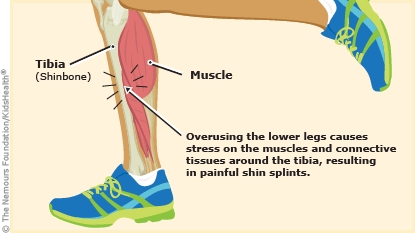People with shin splints have pain on the inner part of the shinbone (tibia). The pain happens because of repeated stress on the muscles, tendons, and bones in the lower leg.
Shin splints usually get better with rest and do not cause lasting problems.

Activity:
- Your child needs to cut down on or stop all activities that cause pain. This may mean taking a few weeks off from sports that include running and jumping. Walking and non-weight-bearing exercises (like swimming or riding a bike) usually do not cause pain and can be continued.
- Your child can gradually add more intense activities after being pain-free for 2 weeks. If an activity causes any pain, your child needs to stop doing it and take more time to heal. They can try it again or do a less intense version of the activity when the pain goes away (usually after a day or two).
To help with pain and swelling:
- Give your child acetaminophen (Tylenol® or a store brand), ibuprofen (Advil®, Motrin®, or a store brand), OR naproxen (Aleve®, Naprosyn®, or a store brand) as recommended by your health care provider. Follow the directions on the label for how much to give and how often.
- Place ice wrapped in a towel on the shin(s) for about 20 minutes several times a day. Do not put ice directly on the skin.
- Have your child put an elastic wrap around the shin or wear a compression stocking.
Follow your health care provider's advice for:
- Any movement exercises or stretches your child should do and any activities to avoid
- Whether your child needs to go for X-rays or other imaging studies
- Whether your child should go to a bone doctor (orthopedist), sports medicine doctor, or physical therapist to help them create a plan for returning to full activities and sports
- When your child should follow up

What causes shin splints? Shin splints happen when someone does the same movement over and over (for example, running and jumping in basketball, football, soccer, and dancing). They also can happen if a person makes a sudden change in an exercise routine, such as exercising more often or making the workouts more intense.
What can help prevent shin splints from coming back? To help prevent shin splints, your child can:
- Wear shock-absorbing athletic shoes with arch support.
- Replace athletic shoes that don't fit well or are worn out.
- Increase any exercise routine slowly.
- Work with a trainer or coach to train safely.
- Cross-train by doing different kinds of exercises on different days.



